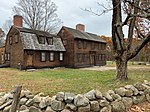Jacob Whittemore House
1716 establishments in the Province of Massachusetts BayBuildings and structures completed in 1716Houses in Lexington, MassachusettsMassachusetts in the American RevolutionMinute Man National Historical Park ... and 1 more
Residential buildings completed in the 18th century

The Jacob Whittemore House is a historic American Revolutionary War site in Lexington, Massachusetts, United States. It is part of today's Minute Man National Historic Park. It is located on Airport Road, just off Battle Road (formerly the Bay Road). It is the only house of the "witness" houses of the April 19, 1775 battles of Lexington and Concord to fall inside the Lexington town line; the others are in Lincoln or Concord.In 1775, the outbreak of the Revolutionary War, it was the home of Jacob Whittemore; his wife, Elizabeth; their daughter, Sarah; Sarah's husband, Moses; and their three small children.The Whittemore family sold the property in 1780.
Excerpt from the Wikipedia article Jacob Whittemore House (License: CC BY-SA 3.0, Authors, Images).Jacob Whittemore House
Battle Road Trail,
Geographical coordinates (GPS) Address Nearby Places Show on map
Geographical coordinates (GPS)
| Latitude | Longitude |
|---|---|
| N 42.44905 ° | E -71.2675 ° |
Address
Battle Road Trail
Battle Road Trail
01731
Massachusetts, United States
Open on Google Maps







